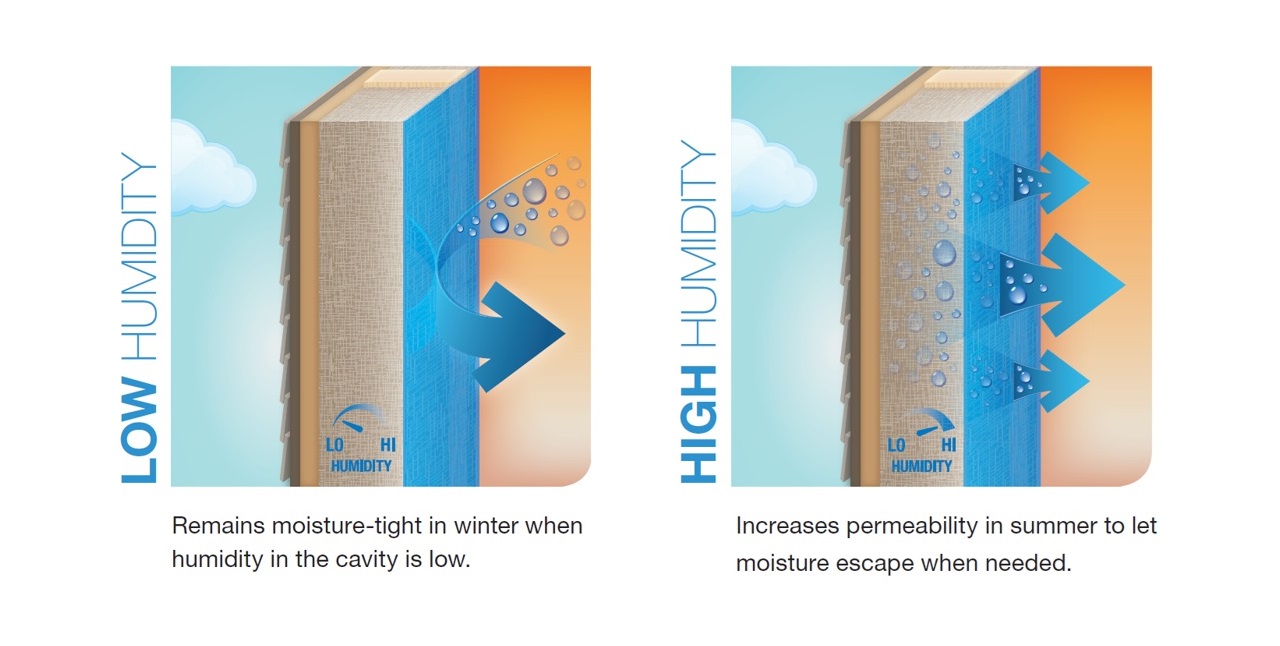Managing Moisture Is All About the Control Layers
With an increasing need for more energy-efficient homes — whether driven by code changes or the desire to reduce heating and cooling costs — it can be difficult to know if you will cause moisture issues in the pursuit of performance.
You may have heard it said that buildings need to “breathe” and that mold problems are caused by increased air-tightness standards. But the truth is, buildings don’t need to breathe, and implementing sound moisture management principles is the means of preventing mold and rot without sacrificing the energy performance that comes from good air tightness.
When a building enclosure is designed, built, maintained, or renovated incorrectly, you might end up with moisture damage. This may be evident from mold growth inside the wall, wood rot, or the presence of termites or other pests.
To avoid this damage and to limit the risk of costly moisture and mold issues, structural damage, and health hazards, it is important to implement control layers in walls and roofs that ensure air movement, heat transfer, bulk water, and water vapor are managed.
There are many sources of moisture in and around a home. Some well-known examples are rainwater and showers, but there are many others that may not be so immediately obvious. These include exterior sources like groundwater and interior sources like perspiration, cooking, laundry, and house plants. This moisture ends up as water vapor in the air — namely humidity.
Humidity can be understood in a few ways:
- Absolute Humidity: The mass of water over the total volume or mass of air. This does not change with temperature.
- Relative Humidity: Air’s capacity to hold water vapor drops as the temperature goes down. Relatively humidity is the ratio of how much water vapor is in the air to how much water vapor the air could potentially hold at a given temperature. The colder the air, the less water vapor it can hold before it condenses into liquid water.
- Dew Point: The temperature at which 100% relative humidity would be reached. When air is cooled below the dew point, airborne water vapor will condense into liquid water (as you see on cold mirrors after you take a shower).
- Vapor Pressure: The pressure that drives vapor from warm and humid to cold and dry, like how a temperature difference drives heat flow from hot to cold.

Building scientists use vapor pressure to determine the direction and speed that vapor will move. They can also use relative humidity and temperature to predict mold growth. According to ASHRAE 160, Criteria for Moisture-Control Design Analysis in Buildings, mold typically grows when relative humidity is above 80% and the temperature is above freezing. This means we want to specify the combinations of materials to prevent these conditions from forming inside a wall or roof.
Let’s consider an example: In mixed-climate parts of the country where homes are heated in the winter and cooled in the summer, the direction water vapor moves changes with the seasons. In the winter, it is very cold and dry outside, but warm and humid inside. Water vapor is driven from inside the house to the outside, and without a properly specified vapor retarder behind the drywall to slow the vapor movement, water is much more likely to accumulate on the cold sheathing, causing mold once temperatures rise above freezing.
In the summer when it is hot and humid outside but colder and dryer inside, vapor-pressure differences force vapor through the building envelope from outside to inside where it can get trapped behind the vapor retarder and accumulate. This could then drip down onto the bottom plate of the walls and cause mold and structural rot.
A high-performance air barrier and smart-vapor retarder, like CertainTeed’s MemBrain™, is one example of building innovations that prevent moisture from entering in the winter while letting moisture escape in the summer.
MemBrain, which is more vapor impermeable in winter when humidity in the cavity is low to prevent moisture from entering the wall, and increases permeability in summer keeping the wall dry, effectively handles two of the four control layer functions: vapor and air.
To further control moisture and mold issues, builders can consider CertainTeed’s One Precision Assemblies, which offers full-service wall, roof, and floor panels carefully engineered for optimal moisture management.

Latest from NAHBNow
Jan 20, 2026
Plan Early for Summer Internship Season with NAHB ResourcesThe most effective internship programs don’t come together at the last minute. To help, NAHB offers the Internship Program Development Guide and Appendices to the Internship Program Development Guide.
Jan 20, 2026
Smart Sourcing, Smarter Basis: How AI Is Changing Land AcquisitionFor decades, the process of screening off-market sites has remained painfully slow. But a shift is happening as top-tier land teams are moving away from manual data aggregation and toward AI-driven workflows to eliminate non-viable sites in minutes.
Latest Economic News
Jan 20, 2026
New Single-Family Home Size Trends: Third Quarter 2025New single-family home size has been generally falling since 2015 as a response to declining affordability conditions. An exception occurred when new home size increased in 2021 as interest rates reached historic lows. However, as interest rates increased in 2022 and 2023, and housing affordability worsened, the demand for home size has trended lower.
Jan 20, 2026
Third Quarter 2025 Multifamily Construction DataAccording to NAHB analysis of quarterly Census data, the count of multifamily, for-rent housing starts increased during the third quarter of 2025. For the quarter, 119,000 multifamily residences started construction. Of this total, 114,000 were built-for-rent.
Jan 19, 2026
Soft Conditions for Single-Family Built-for-RentSingle-family built-for-rent construction fell back in the third quarter of 2025, as a higher cost of financing and increased multifamily supply crowded out development.
